By Tom Darling, Conversations with Classic Boats
Photos by the author, Princeton 1975, and Hali Liu, Princeton 2025
Princeton University Sailing, which lays claim to being the oldest intercollegiate sailing team, has entered into an innovative collaboration to house its dinghy sailing activities at Anchor Yacht Club, a member owned and maintained club on the Delaware River.
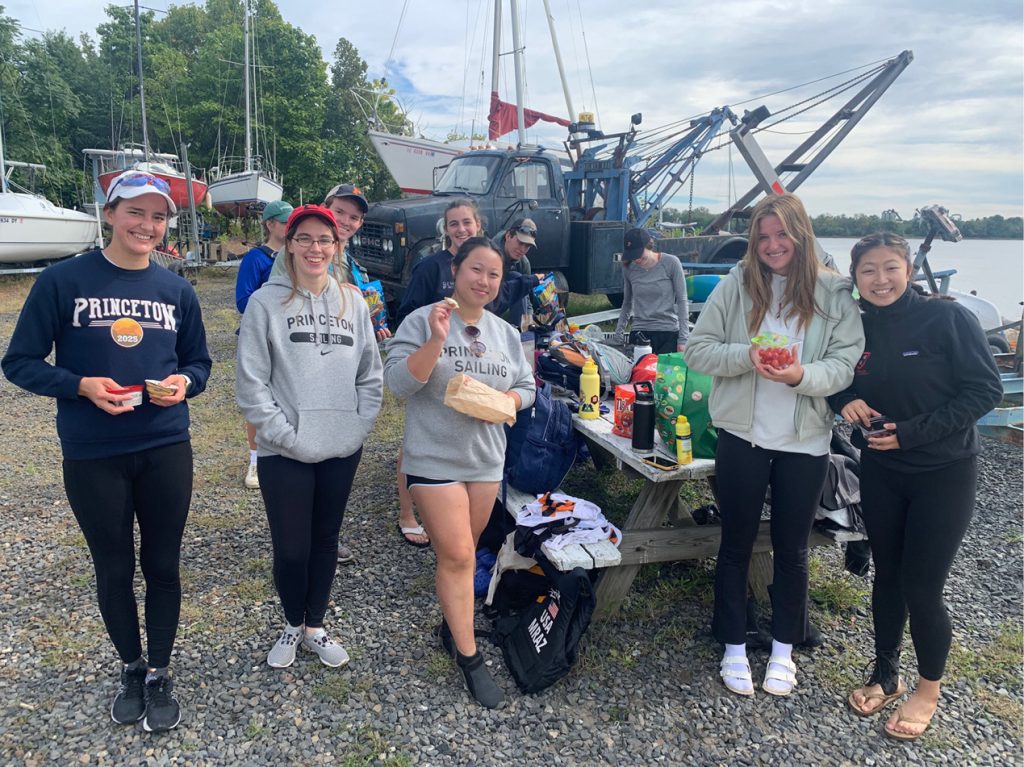
Snack time for Tigers at the new home of Princeton Sailing, Anchor Yacht Club in Bristol. PA © conversationswithclassicboats.com
The collaboration, or CoLo (“Co-Location”) as I call it, went into its second year in September 2022 with the arrival of the team’s new fleet of twelve Zim Sailing 420Es and its use in the opening regatta at the site, Princeton’s Fall Open. Princeton continues to have reciprocal arrangements for its big boat team with its former host, Raritan Yacht Club in Perth Amboy, NJ, and works with Oakcliff Sailing in Oyster Bay, NY on sponsoring keelboat events.
How does a collegiate sailing team without a home find itself a new home? That story is at least thirty years in the making. Starting in the 1990s, Princeton Sailing had been the guests of Raritan Yacht Club, itself dating back to the post-Civil War boom in boat clubs in the New York City area. That question of a home first became an issue when Hurricane Sandy swept Raritan YC’s base clean in 2012. Fortunately, the team’s fleet of Flying Juniors and its Boston Whaler had been recovered the day before. But the aftermath and rebuilding of the site limited the team for years to come.
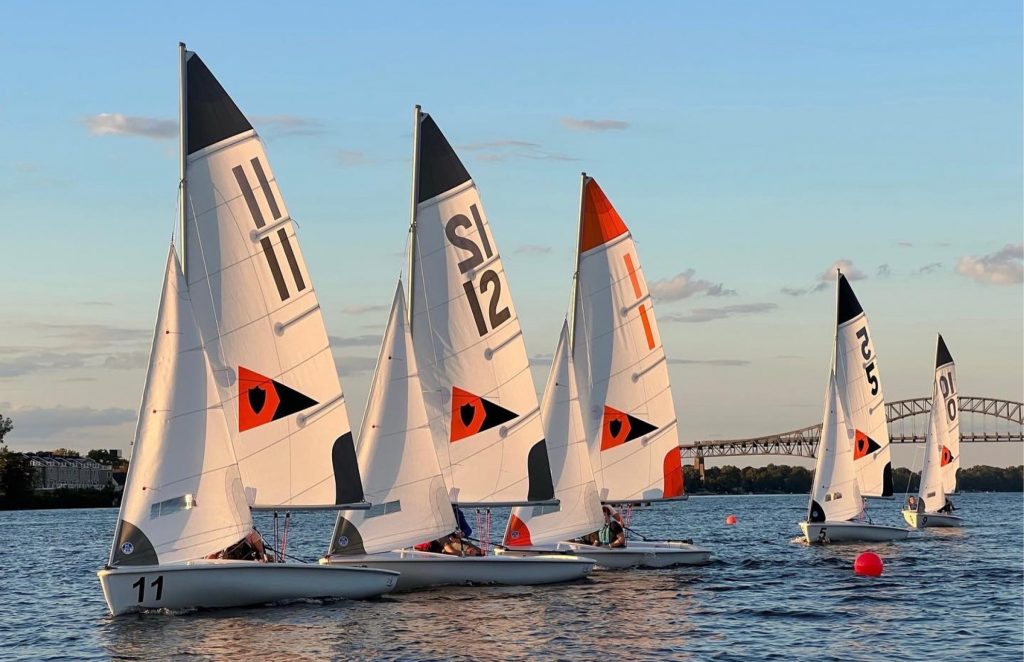
The team has a new fleet of Zim 420Es (and the best colors in collegiate sailing Ed.). © Hali Liu
I was bobbing in Raritan Bay doing race committee for the Princeton Fall Open in September 2017 when the germ of the idea to find a long-term collaboration reemerged. Adrienne Mandelbaum, whose older sister Sydney is the youngest member of Princeton Sailing’s Alumni Board, asked the question we have often asked on the Sailing Team: “Is there somewhere else we can go?”
It was 2019 when the Princeton Alumni Advisors came back to the question. Bob Johnstone in Charleston, SC, co-founder of J Boats, and Dick Rose of Seattle, WA, world-renowned master of the Racing Rules, were our group industry heavies. Separately, they had been up late nights on their computers, poring over Google Maps looking for possible sites on a radius of fifty miles from the Princeton campus. We searched the states of New Jersey and Pennsylvania. I called it the Goldilocks search: Too far, not big enough, not accessible – we tested the same criteria through site by site.
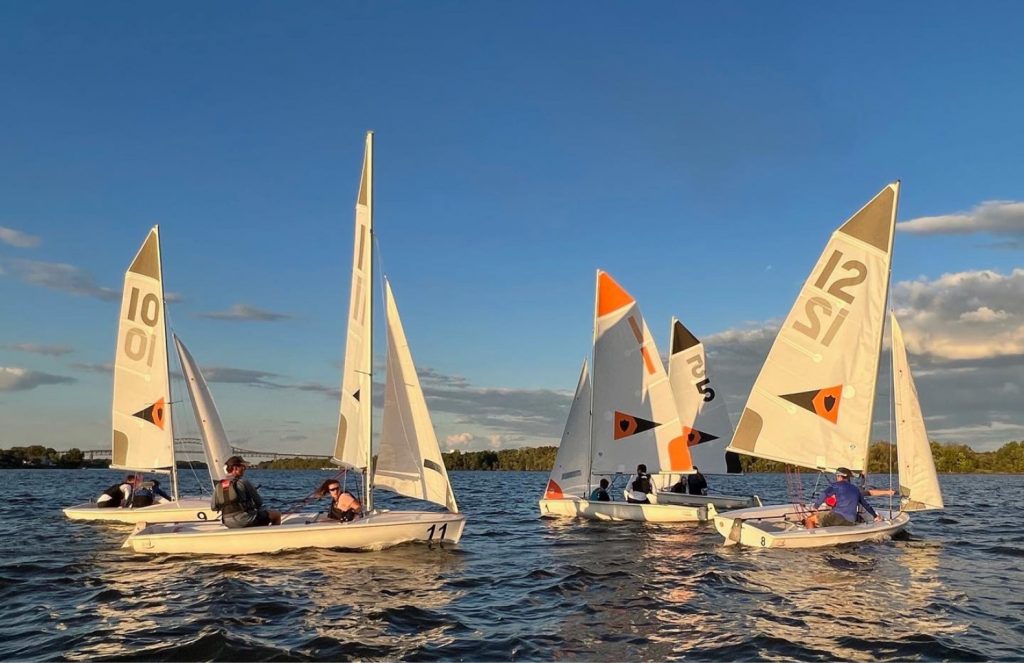
The team hosted their first regatta at Anchor YC, the Princeton Fall Open, in September. © Hali Liu
Our leading initial candidate was Lake Mercer, a Mercer County park with a large, winding man-made lake ten miles from campus. Good news. The bad news was Mercer was dominated by rowing programs for high school and amateur oarspeople. The physical layout was problematic, and the boat storage was an issue. But the politics were impossible. To a rower, a sailor is an eccentric elitist operating a pesky, erratically moving craft. We moved on from Mercer, to our chagrin.
Returning to our satellite mapping, we found lakes to the north of Princeton that were too small. A promising man-made lake close to the Delaware River turned out to be owned by a mega waste management company that had grandfathered dozens of seasonal vacation shacks along its borders. Getting access to the water was one problem; building a boat storage facility, we concluded, was not in the cards.
Finally, Bob Johnstone and the young head of the Advisory Board, Anthony “Ant” Pappenfus, who had been Treasurer of the Princeton YC as a 2013 graduate, turned their attention to scouring the Delaware River from Philadelphia north and Trenton south. The Penn team had relocated from the Schuylkill River dominated by the oldest rowing venue in America, home to iconic boat clubs like Vesper. To us, Penn’s downriver location near the airport seemed like putting your base by the runways at Newark or Laguardia. We wanted a little better view.
Bob and Ant doggedly evaluated a pair of clubs on estuaries off the Delaware River at the same latitude as downtown Philadelphia. It took forever to get the attention of the officers of clubs in the off-season. We ruled out the first club – too remote and too far to the sailing area. The second had no place for docks.
That left one last club. It was the Anchor Yacht Club in Bristol, PA, established in 1906 on a bluff over the west bank of the Delaware, with a small but active sailing community and a great sense of hospitality. Located in Bucks County about fifteen miles south of Trenton, NJ, Anchor YC is about twenty-five miles below where General George Washington forded the ice floes of a frozen river to make history, crossing the river and providing the subject of a famous painting. AYC is one of thirty-one Delaware River Association clubs, many of them well over a century old. Princeton Sailing was truly crossing the Delaware.
Sitting over a wide section of a commercial ship channel from Delaware Bay to the Trenton Falls, the club grew across from the 300-acre marshy Burlington Island that was at the turn of the 20th century a major recreational space, complete with an amusement park and an escape for Philadelphia residents fleeing the summer heat. Trains and ferries took residents north from Center City. Fire destroyed the park in the 1920s and 1930s. Today, it is empty space that channels the prevailing southwest breeze down to the racecourse.
Everything seemed right: a good open racecourse, space to store boats, and helpful club members. Our concern was sharing a shipping channel with maximum seasonal powerboat traffic and not none but minimal commercial shipping traffic. But the yacht club officers convinced us that although very busy and not too windy in high summer, the river was clear in the spring and fall shoulder seasons.
Anchor YC Commodore Mike McDemott told me the story of how the CoLo concept came about. The idea was that Princeton Sailing would pay an annual rent for the use of storage, launching, and dock space. Anchor YC members would help the team make any improvements that they agreed on. It was a very simple treaty.
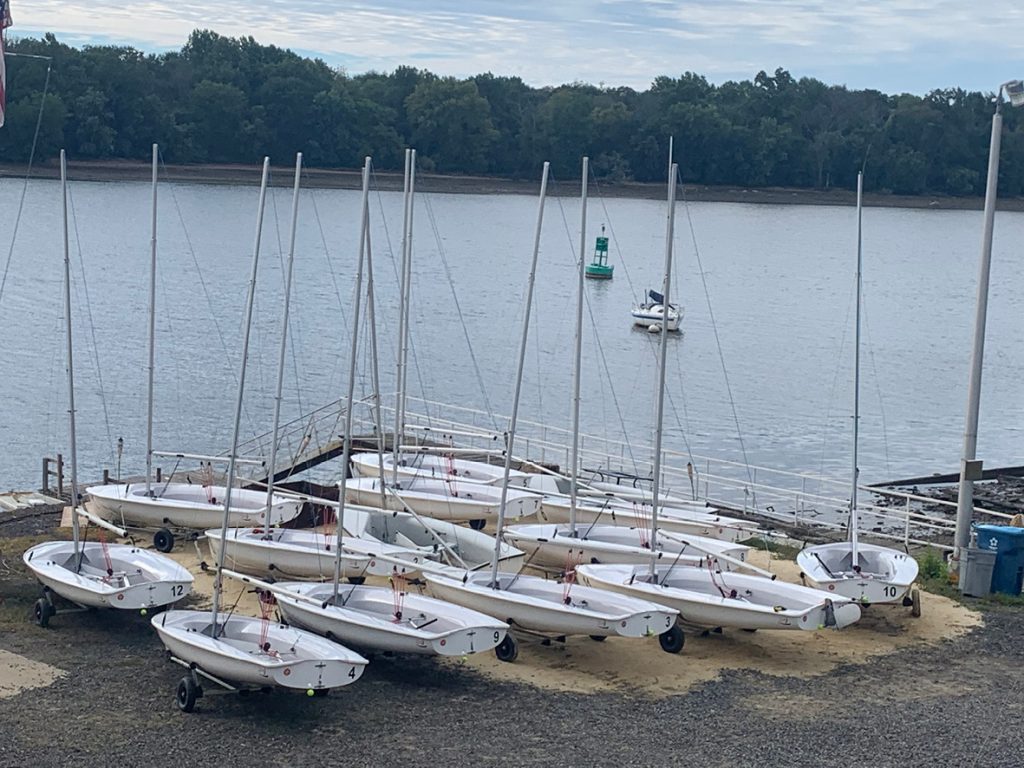
A Princeton Civil Engineering major is designing floating storage docks for the fleet. © conversationswithclassicboats.com
Mike met Ant Pappenfus on a blustery day in 2021. “A guy was standing on the grounds and I asked if I could help him,” Mike recalls. He told me, ‘We’re looking for a yacht club that we can locate Princeton Sailing at,’ and we went from there.”
Exactly what is this term “CoLo”? The truth is I made it up. Although it is done quite often with community sailing programs like Sail Newport or Nantucket Community Sailing, it has been an arrangement less well known for college teams. The first step is an agreement between the host club and the team. Terms and condition cover economics, and the club earns annual rental revenue. But what is notable is the cooperative element.
The team needs storage for sails. The club offers to locate a prefab building. The team wants to take their boats from the dollies and give them a permanent home on docks set in the river. The club members, all of whom do all the maintenance of their own club, offer tools and labor to make permanent improvements on the site, including sail and equipment storage.
It is truly a cooperative venture. A good Co Lo requires the support and communication of all players. The Anchor YC fleet of power- and sailboats has a season from late April to late September. With 200 feet of dock frontage, they support an active group of daysailers with a handful of auxiliaries over 30 feet. In the fall, they sponsor a number of races up and down the river. They extend invitations to Princeton sailors to join them in racing if they can. But in any case, the club’s schedule is very complementary to the college sailing calendar.
Anchor YC officers go out of their way to anticipate the needs of the sailors. The 2022 addition was a bathroom at river level. This was much appreciated by college competitors encased in drysuits all day. High up above the river, members can watch the action on the racecourse. During September’s Princeton Fall Open regatta, members had their own viewing party on their upper deck. When racing was done, the Anchor officers cooked up a Bucks County BBQ with burgers and local fixings from the nearby Amish market. Whether they had had driven six hours or twenty minutes from campus, the visiting teams from Virginia, RIT, Drexel and Monmouth enjoyed the food and the camaraderie. That’s what college sailing is all about.
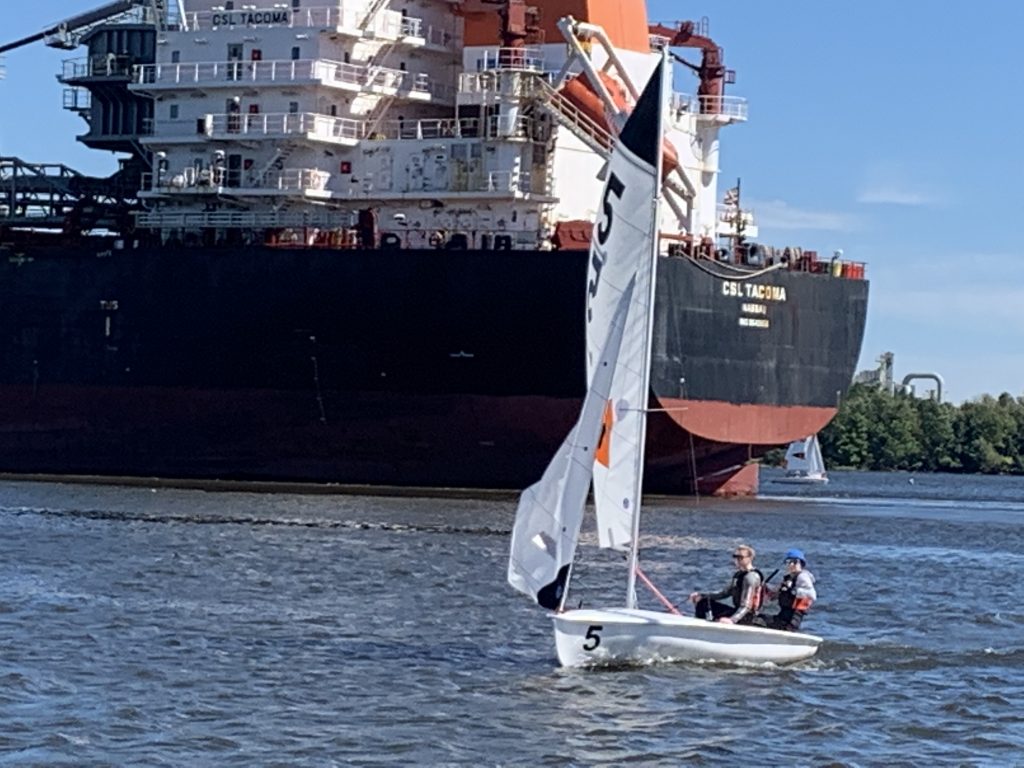
Past Commodore Jim Morrissey has really enjoyed having the college sailors at Anchor. “They are very respectful,” he said. “They take good care of their equipment. We really like having the kids. There is action now at the club after our boats come out.” Jim was sitting back enjoying the racing and a cigar on the observation deck. I was especially happy that Jim was there – to borrow a screwdriver from Jim’s trunk to fix a sheared centerboard control bolt on one of the boats.
The Commodore who championed the CoLo deal for Anchor YC, Mike McDermott, has one of the largest boats in the river. He admits it took a year of trial in 2021 to get the membership comfortable. Now that members see the light footprint of the team, and have enjoyed being the host for college competition, it is thumbs up.
Next on the docket is the installation of docks in the river retrofitted with cradles to house the dozen new Zim 420Es. The 8-foot rise and fall on the tide presents some engineering challenges. But with minimal fuss, the team can repurpose a pair of 8 X 20-foot dock sections with chocks for each boat, allowing them to keep rudders on and cutting the time for rigging and launching a 12-boat fleet by a third. Anchor YC already has 220 feet of riverfront dockage, with underwater arms anchoring them to the waterside bulkhead. A young Princeton Civil Engineering student will apply her skills over the winter to come up with an elegant and durable floating storage solution for the Princeton fleet.
The goal of the new home, says Bob Johnstone, is very clear: “A sign on site will say, ‘A National Championship for Princeton Sailing.’” From acorns grow mighty oaks. And it could not happen without a CoLo. A willing and eager yacht club plus a top college sailing team equals a win-win solution.
Teams interested in exploring this option should feel free to contact me at tcd4sail2@gmail.com. We will feature this story over the winter at our Conversations with Classic Boats podcast. To learn more about Princeton Sailing and their new home at Anchor Yacht Club, visit princetonsailing.com and anchoryachtclub.org. ■
Scan here to tune into the author’s Conversations with Classic Boats podcast.

Scan here to tune into the author’s Conversations with Classic Boats podcast.
A 1975 graduate of Princeton University, Tom Darling was captain of the school’s Varsity Sailing Team in 1974 and ’75. An ardent supporter of Princeton Sailing, he’s involved with such events as the Hamilton Burr Regatta, a match race duel between Princeton and Columbia University. Hosted by Hudson River Community Sailing, the HBR was conceived to perpetuate the legacy of competitive spirit and civic responsibility of patriots Alexander Hamilton and Aaron Burr.
